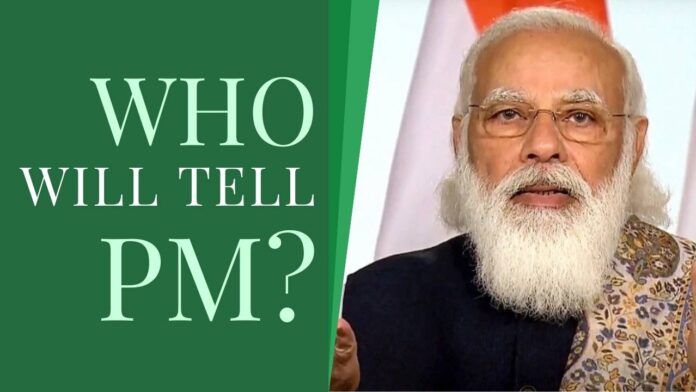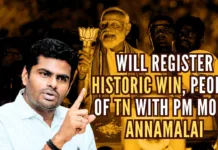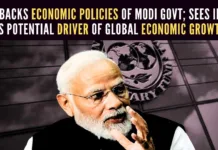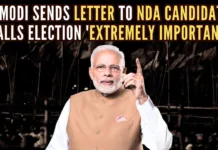
First time in many years political executive was interacting with armed forces and directing them to do something instead of mouthing inane homilies
The Prime Minister while addressing the valedictory session of the Combined Commanders’ Conference (CCC) stressed the importance of enhancing indigenisation in the national security system, not just in sourcing equipment and weapons but also in the doctrines, procedures and customs practised in the armed forces[1]… He also called for a holistic approach, focused on breaking down civil-military silos… He advised the Services to rid themselves of legacy systems and practices that have outlived their utility and relevance… For the first time in many years, the political executive was interacting with the armed forces and directing them to do something instead of mouthing inane homilies. Heartening. While the overall slant of the address was great and positive, the larger message on the requirement of indigenous doctrines, procedures and customs in the armed forces and focus on breaking down civil-military silos need examination. We should not embark on a senseless indigenisation programme or come out with routine instructions like the one below.
Indigenous customs, traditions and procedures
“Ram Ram Sahab, main gunner operator Reddy aapka sahayak hun”. If you hear this conversation in isolation, you might wonder as to what’s happening in the Army. Hold on. This conversation took place in December 1977 between me and my first Sahayak. Why was Gunner Operator Reddy from Kurnool, who barely knew Hindi, chanting ‘Ram Ram’? He was just following one of the deep-rooted Indian customs and traditions of the armed forces – greeting each other with ‘Ram Ram” – it’s quite natural. There are many more. ‘Ram Ram’, ‘Jai Hind’, ‘Jai Durge’, ‘Jai Mata Di’, ‘Sat Sri Akaal’, ‘Namaskaram’, ‘Vannakam’ and ‘Salam Aleikum’ are some normal forms of greeting in units, depending on their class composition. Battle cries like ‘Bole So Nihal…Sat Sri Akal’, ‘Bol Durge Mata ki Jai’,’ Hanuman ki ho Pyare’ also signify that deep rootedness. When a Jawan dies for ‘Naam Namak aur Nishan’ it is an endless continuity of Indian ethos, culture and practices. Each unit has a Mandir, Gurudwara, Gompa, Church or an Idgah. I have followed the rigor and rituals (beyond normal festivities) of major festivals events like Deepawali, Janmashtami, Navratras, Gurpurab, Losar, Christmas or Eid uncompromisingly when serving with different units. As an officer, my religion was that of my troops. Their customs and traditions were mines. Period. Morale, tales of valour – contemporary and mythological, value system, tradition, ethics, motivation, team spirit, ethos, pride in the unit, arm, service and nation are recounted and ingrained into all ranks, families and children through such traditional customs. Panditji must do puja first thing in the morning along with ‘stand to’, otherwise our guns do not fire, even in battle. That was and is true for any major event in my unit and in all units of the Army. Units function on a ‘Unit Dastoor’ – a grass-root code which is peculiar to each unit, but sacrosanct it. The normal Indian Army officer, JCO (Junior Commissioned Officer) and Jawan carry out myriad duties all over India – flood relief, riot control, election duties etc. These could happen anywhere between Indira Col (head of Siachen Glacier) to Indira Point (tip of A&N Islands) and Lakhpat to Kibithu – beyond the normally understood Kashmir to Kanyakumari construct of India.
The Bangladesh War is the best example of a blitzkrieg and the Kargil War is the best example of overcoming unsurmountable odds – won through fundamentally Indian ideas.
Today as I write in English, I behave like a Rajput (having commanded a Rajput Unit), understand a Gorkha, emote with a Sardar, work like a Maratha, commiserate with an Assami, recognise a Manipuri and continue to be a Telugu living in Tamilnadu. I have learnt about Dimasas, Garhwalis, Ladhakis, Gujars, Mappilais, Bhils, Parsis and many more ethnicities and tribes, having rubbed shoulders and eaten dal-roti with all of them. My transformation from a Chennai teenager with a provincial outlook to a complete Indian fiercely proud of India and its customs, traditions, and practices was enabled by the Army, over four decades. The procedures and customs of the Indian Armed Forces are built on this solid edifice of being Indian and upholding the Constitution of India at any cost. It has stood the test of time and delivered for India consistently. Do not get carried away by the spit and polish on public display by the Indian Armed Forces. That comes from Drill – The bedrock of discipline. Without that hard outer core of the discipline, the system will collapse. I have not seen any institution in India which is more Indian than the Indian Armed Forces in ethos, procedures and customs practised on a 24×365 basis. That is why an overwhelming number of Indians have complete trust in the armed forces. Who will tell the Prime Minister?
Indigenous doctrine
The military doctrines of a nation are a fundamental set of principles that guide military forces as they pursue national security objectives. Doctrine is also a synthesis of the study of great thinkers, military history overages, cultural documents, religious edicts, traditions, legacies, societal norms and much more, both Indian and international. It is also guided by principles and national interests enshrined in the Constitution of India. This derived doctrine is translated into hardcore execution plans based on the terrain/ environment, enemy and own forces. The underpinning of all this is the comprehensive national power. From a different angle, the military doctrine and practice of any nation are influenced by works of great masters – like Chanakya (Arthashastra), Sun Tzu (Art of War), Clausewitz (On War), Liddel Hart (The Strategy of Indirect Approach), Niccolò Machiavelli (The Prince) and more.
In the Indian context, this is reinforced by our two great epics – Ramayana and Mahabharata. Bhagavad Gita has a deep imprint on the way we fight. ‘Yada yada hi dharmasya glanirbhavati bharata, Abhyuthanamadharmasya tadatmanam srijamyaham, Paritranaya sadhunam vinashaya cha dushkritam, Dharmasangsthapanarthaya sambhabami yuge yuge’. Most of us know the sloka by heart. Many do not realise that Indian military doctrines strategies, tactics and general behaviour is a sub-consciously extension of such wisdom contained in our epics. The DSSC (Defence Services Staff College), Wellington have halls called ‘Ashoka’, ‘Carriappa’, ‘Chanakya’, ‘Chandragupta’ and so on. That is our primary institution where military doctrine is imbibed in a formal manner by all armed forces officers who go there. Such practise is followed almost in every training establishment. Heroes, great battles and exploits of each unit, arm and service are conveyed with pride on pathways/ halls/ institutions of each regimental centre, training institution and unit to all ranks and public. The Bangladesh War is the best example of a blitzkrieg and the Kargil War is the best example of overcoming unsurmountable odds – won through fundamentally Indian ideas. These battles and many indigenous ones have formed the basic syllabus for study in promotion exams.
Our military doctrine is not only steeped in Indian cultural and military history but also Indian terrain cum environmental conditions. Otherwise, we could not have succeeded in the Himalayas, deserts, plains or jungles of India. World War II evokes more memories of the Normandy landings and the European theatre. However, the most important campaign in the allied effort was the ‘Defeat into Victory’ in Burma. Operations like Chindits or Battle of the ‘Admin Box’ in the jungles of this campaign where Indians have shed blood as in Gallipolli or Bir Hachiem have given us great doctrinal sustenance. To all this, one must add the impact of technology and emerging domains of warfare to put a doctrine together. In my opinion, the Indian Armed Forces have evolved a method of fighting relevant to the Indian context. It is a terrific blend of the ancient and the modern, the indigenous and international thought. Tampering this balance with over-indigenisation could lead to dogma. Finally, it does not matter which doctrine one applies, we have to be victorious in war. That is the acid test which we have consistently passed. Who will tell the Prime Minister?
The Chinese model in which the political head and the military head are the same. The US model, where the relationship between the civil and military has been enacted through the Nicols Goldwater Act.
Civil-Military silos
Breaking down civil-military silos to enhance national security and defence is an issue of the first order. First, we must identify the silos. There are two varieties of silos – external and internal. The external silos to the MOD (Ministry of Defence) are the MEA (Ministry of External Affairs), MOH (Ministry of Health), DAE (Department of Atomic Energy), Dept of Space and DST (Department of Science and Technology). These disjointed silos affect national security and must be bridged. The bridge could be the NSA (National Security Agency) or any other designated authority under the PM. It has to be a political process and cannot be a military one. A relevant model is the Chinese United Front Works Department[2]. It has acquired the reputation of being a magic wand to break Chinese silos. The internal silos also have to be broken. The silos are the MOD, MOD (Finance), DDP (Department of Defence Production), DRDO (Defence Research and Development Organisation), OFB (Ordnance Factory Board), DPSUs (Defence Public Sector Undertakings), and the services. The Inter-Service gaps are being bridged by the DMA (Department of Military Affairs) and the ongoing thrust on enhancing jointness and implementing theatrisation. Silos external to Services have come about due to outsourcing of political responsibilities to bureaucrats. If the PM wants ‘civil-military silos broken and decision-making to be expedited beyond weapon procurement’, the political class must get more invested in the military on a one to one basis. The practice of outsourcing defence issues to bureaucrats must cease. At present, the MOD is not integrated. Attempts at the integration of the civil and military bureaucracy have failed due to a lack of political interest or will. In this context, the DMA is a positive and welcomes development for which the nation must thank the PM. Enhanced civil-military cooperation can come if service officers man the MOD, MOD (Fin), DDP, OFB, DPSUs and DRDO in adequate numbers, in responsible higher echelons and not as security or liaison officers. Service officers must also be deputed to those departments where there are defence interests to enhance connectivity between silos. Also, a deputation from other departments into MOD must stop. I wonder what an officer from Animal Husbandry or Agriculture can do in MOD that a service officer cannot. I have written extensively on this in my articles earlier[3]. The silos can only be broken down if the political class wants it so and drive the system. A word of caution. Breaking down silos should not be the garb under which the armed forces are politicised. Equally, this should not be the vine on which politically greedy military officers climb the ladder. We need to find a balance based on intellectual honesty. All I will say is that whenever ‘Civil Control’ over the Military turns to ‘Political Control’ and not ‘Bureaucratic Control’ all silos will be broken. We have two models based on which we can evolve our own. The Chinese model in which the political head and the military head are the same. The US model, where the relationship between the civil and military has been enacted through the Nicols Goldwater Act. The choice rests with the PM, in whom I have hope. Who will tell the Prime Minister?
Conclusion
The PM is correct in saying that we have too many legacy systems which the services have to ruthlessly weed out. They are only dead weight. Needs internal correction. The PM has also spoken of optimising manpower planning in both military and civilian parts of the national security architecture. It is for reflection that lakhs of servicemen are recruited, trained and sent on pensioned unemployment when they are still young. On the other hand, we keep raising paramilitary forces ceaselessly. We then put an ineffective leadership on top of these hapless men who keep getting them sacrificed as it happened recently in Chattisgarh. Achieving optimisation and efficacy in manpower is a political responsibility and not that of services alone. Ultimately, the nation will get a defence structure depending on its investment. If the investment is in political capital, it will be a politico-military structure as envisioned by Chanakya. If not, we will continue with a weak structure, midwifed by bureaucracy. Who will tell the Prime Minister?
Note:
1. The views expressed here are those of the author and do not necessarily represent or reflect the views of PGurus.
References:
[1] PM addresses the valedictory session of the Combined Commanders Conference at Kevadia, Gujarat – Mar 06, 2021, PIB
[2] China’s United Front Work in the Xi Jinping era – institutional developments and activities – Jun 13, 2019, Taylor & Francis Online
[3] POLITICO MILITARY FUSION FOR A ‘FUTURE READY’ INDIA BY LT GEN P R SHANKAR (R) – Mar 10, 2021, Gunners Shot
- Indian Leadership Vs Chinese Virus - May 4, 2021
- Who will tell the Prime Minister? - April 28, 2021
- A Strategic Marriage of an Arranged Partnership - April 22, 2021











The PM was making way for a comprehensive change in our armed forces more from an ‘incremental’ outlook not locked in iterativeness. The Agniveer Programme is an example of such an outlook. It primarily departs from known legacy and doctrine followed by our armed forces. The civil-military part is more of that larger outlook… the possibility of upscaling our NCC cadre as perhaps the third line of defence. No PM has or been interacting with the NCC like it’s been happening these times. Yes! the outlook and the idea is not flawed in its conception… Just that it needs deep introspection, procedural innovation and internal correction to be done by our armed forces and our armed forces alone. Naam, Namak, Nishan shall always remain with us eternally, but that’s not what the PM is out to change. He is primarily making us look at things differently to suite present times… how else would ‘theatrization’ succeed, any guess? I leave it at that…
Good article.
WHO WILL TELL THE PM? It should be RSS to tell PM and or recall him.
Our PM is MK Gandhi 2.0. few years ago he took brave Israel PM Netanyahu to Sabaramati! Had Israel followed Gandhi 1.0 and or 2.0 Israel would have faced few wars by now!
Lord krishna tried several ways to avoid war in Kurukshetra …. rest is an epic and one should emulate Him instead of mouthing Shanti mantras and Vasudaiva Kutumbakam sermons under RSS altar!
Vasudha (World) Eva (Indeed) Kutumbakam (Family), there is a very interesting theory that these shlokas actually were told in the fabled Panchatantra, in the instances where people were warned against such preaching of blind love for the world.
Why should one wage a war ? Indian original legacy is om Shanti, Om Shanti, Om Shanti. We are brain washed with a legacy, non violence got us independence.
Modi is a victim of this legacy. Meets Chinese PM more than 20 times and boasts a senior corrupt politician as his guru. Realisation dawns late. Vasudaiva Kutumbam is a grossly misinterpreted word which Modi often quotes. What Indian Rishis meant was that humans and animals in Bharat part of divine family. They never said all nations belong to one family, or else Bharat would not have shrunk to 1/3 of its original size.
We have to be victorious in war, who will tell PM? Which war ? The worst war we are facing is internal security war, cyber war,mafia war and propaganda war. Unless we overhaul judicial system, we will lose all wars. True, we have best military power, but that is for safeguarding political borders, but what about internal wars ?
Wonderful article❤️❤️❤️💪💪💪🙏🙏🙏👏👏👏
Great article Sir. I fully agree with your views on silos. What I feel is that our Beurocrates, during their preparation for the qualifying examination and the subsequent training after succeeding in the qualifying examination get themselves infused with many doctrines, dogmas, and philosophies that need to be cleansed. What I suggest is that compulsory training of five years for the Beurocrates in the Army before their induction into Beurocracy, may serve the purpose and take care of the different silos.
Who will tell the Prime Minister?
hi,
i regularly read your articles. they are impressive, erudite and spirited.
you have lot to share and your language is mellifluous.
but, it has one flaw, namely, they are too long and dense.
is it possible you consider writing couple of shorter articles instead of one long article?
thank you.
SALUTE Sir. Who will tell the Prime Minister (Who doesn’t appear to be listening) I could be right or wrong but gut feeling is that Narendra Modi is appearing more & more clueless. The more he talks the more he looks silly. Like asking students to attempt tough questions first and trying to say (a+b)2 = a2 + 2ab + b2 yeh 2ab kahan se ata hain and all.
More than any thing there is lack of స్థితప్రజ్ఞత May be politicians do this CHEST THUMPING to create positive perception
Since 2014 many people were giving many suggestions in almost all the fields. Very little improvement. May be we need to be patient and continue to apply pressure. But what if he is not the real doer or say a dummy in front of some invisible force!
Sir, you appear too harsh for the PM. You might be having your own reason. But for me, he is the most sincere PM and he is trying his best
incorrect. In fact indians with conditioned, egoistic ideologies ie literate elite enjoy providing unsolicited advice in blogs and enjoy spreading false narratives of their motherland to western press and about Modi. Listening to others – is a wrong expression. It should be suggestions by professionals. Perhaps Modi is an exceptional PM who interacts more with the professionals and whips babus. His weakness is he is too soft on fake news spreaders, not taking action on loot by politicians in opposition ruled states and gives advice to those who don’t have grasping power.
We now have electric power, good highways, digitalisation and a sense of not relieving next to railway tracks. Indian legacy is always to find fault with others, a colonial syndrome and not taking responsibility. Kindly suggest which type of PM is suitable for India.